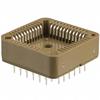Lower-limb prosthesis wearers are more prone to fall than non-amputees. Powered prosthesis can reduce this instability of passive prostheses. While shown to be more stable in practice, powered prostheses generally use model-independent control methods that lack formal guarantees of stability and rely on heuristic tuning. Recent work overcame one of the limitations of model-based prosthesis control by developing a class of stable prosthesis subsystem controllers independent of the human model, except for its interaction forces with the prosthesis. Force sensors to measure these socket interaction forces as well as the ground reaction forces (GRFs) could introduce noise into the control loop making hardware implementation infeasible. This paper addresses part of this limitation by obtaining some of the GRFs through an insole pressure sensor. This paper achieves the first model-dependent prosthesis controller that uses in-the-loop on-board real-time force sensing, resulting in stable human-prosthesis walking and increasing the validity of our formal guarantees of stability.
翻译:低脂假肢磨损器比非假肢磨损器更容易跌落。 强力假肢可以减少被动假肢的不稳定性。 虽然在实际操作中显示比较稳定,但有动力假肢通常使用模型独立的控制方法,这些方法缺乏对稳定性的正式保障,并依赖于休眠调节。 最近的工作克服了基于模型的假肢控制的局限性之一,开发了独立于人类模型的稳定假肢子控制器,但与假肢的相互作用力除外。 测量这些插座相互作用力和地面反应力的感应器(GRFs)可以将噪音引入控制循环,使硬件无法实施。本文述及了这一限制的一部分,通过一个内皮压力传感器获得一些GRFs。本文实现了第一个依靠模型的假肢控制器,该控制器在机上实时电流感测,导致稳定的人脉搏行走,并增加了我们正式的稳定保障的可靠性。




